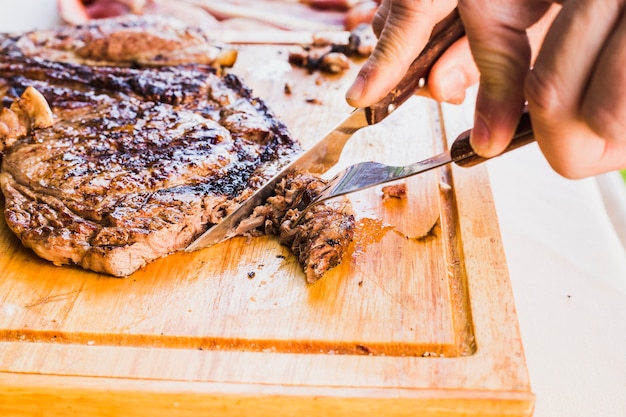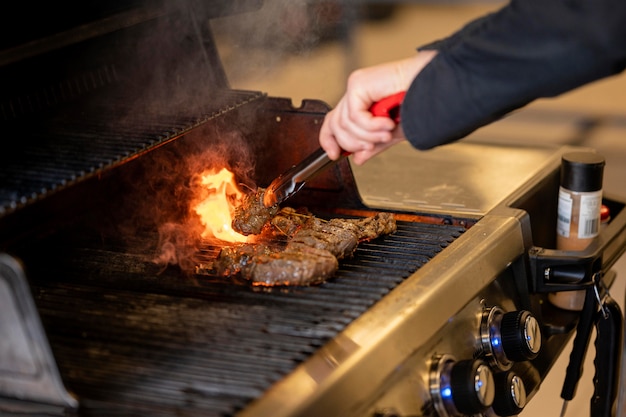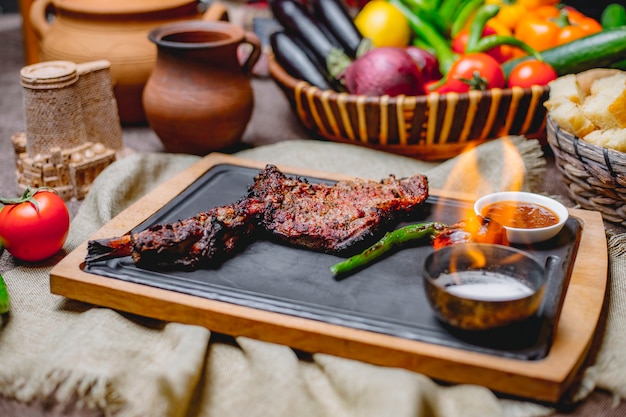Forget the grill! I'm here to tell you that a perfectly cooked steak can be achieved right on your stovetop. Yes, you read that right. No fancy equipment, no outdoor grilling, just a trusty pan and a bit of know-how. It's all about technique, the right pan, and a touch of patience. You'll be surprised at the delicious results!
I've spent years honing my stovetop steak skills, learning from both successes and the occasional charred disaster (we've all been there!). Now, I'm confident in consistently producing juicy, flavorful steaks that are seared to perfection. And the best part? You don't need any special culinary talent – just a willingness to follow these steps and experiment a little.
Ready to embark on this delicious journey? Let's get started!
(Part 1) choosing the right cut: The Foundation of a Great Steak

Picking the Perfect Piece: Beyond "Any Old Steak"
It's tempting to grab the first steak you see, but trust me, choosing the right cut is crucial for a truly satisfying stovetop steak. Different cuts are suited for different cooking methods and preferences. Some are thicker and more forgiving, while others are leaner and require a lighter touch.
Here are my top picks for stovetop cooking, based on years of experience:
- Ribeye: This is the king of steaks! It's marbled, juicy, and bursting with flavour. The rich fat content ensures a juicy, tender steak that's perfect for thicker cuts.
- new york strip: Leaner than ribeye but still incredibly flavourful, the New York Strip yields a beautiful sear and a satisfyingly chewy texture. It's a great choice for those who prefer a leaner steak.
- Sirloin: A versatile cut that's a good all-rounder. It's less marbled than ribeye, but still delivers on flavour. Sirloin is perfect for a quick weeknight meal or a more casual gathering.
- filet mignon: The most tender cut of all, filet mignon is also the leanest. If you crave a delicately melting steak, this is your go-to choice. Just remember that its leanness means you'll need to cook it carefully to avoid dryness.
- flank steak: This cut is a bit more challenging to cook as it's thinner and can dry out quickly. However, its robust, beefy flavour makes it a favourite for those who enjoy a bolder taste.
Thickness Matters: A Key Factor in Even Cooking
The thickness of your steak is just as important as the cut itself. Thicker cuts are ideal for stovetop cooking because they retain heat better and are less prone to drying out. Aim for a steak that's at least 1 inch thick. If you happen to find a thinner steak, don't worry – you can always cook it in two batches to ensure even cooking.
Bone-in: Adding a Touch of Rustic Charm
Don't shy away from bone-in steaks! They're actually a great choice for stovetop cooking. The bone acts as a heat conductor, helping the steak cook more evenly and adding a delicious, primal flavour.
(Part 2) Preparing Your Steak: Setting the Stage for Success

Room Temperature: Unlocking Even Cooking
Before you even think about firing up the stove, let your steak come to room temperature. This simple step makes a huge difference in achieving even cooking. A cold steak takes longer to cook and might not cook evenly, leading to a dry or unevenly cooked steak. Take it out of the fridge 30 minutes before you plan to cook it, and let it hang out on the counter. This allows the steak to warm up and relax, ensuring that it cooks more evenly.
Pat it Dry: The Secret to a Beautiful Sear
Once your steak is at room temperature, pat it dry with a paper towel. This is crucial! A wet steak won't brown properly. The moisture will steam instead of sear, resulting in a pale, less appealing exterior.
Seasoning: Simple is Best
Now for the fun part – seasoning! I believe in keeping things simple. Salt and pepper are all you need to enhance the natural flavour of the steak. Salt is key for drawing out moisture and flavour. Generously salt both sides of your steak, making sure the salt is evenly distributed. I prefer kosher salt for its larger crystals, which distribute more evenly and don't dissolve as quickly. But table salt will work just fine. Now, add a generous grind of freshly ground black pepper. A good quality pepper mill makes all the difference!
Feel free to add other seasonings if you like, but keep it light. Remember, you want to enhance the natural flavour of the steak, not overpower it.
(Part 3) Choosing the Right Pan: Your Essential Stovetop Ally

Cast Iron: The King of Stovetop Cooking
You need a good, heavy-bottomed pan for stovetop steak cooking. The absolute best choice is a cast iron pan. These pans are known for their incredible heat retention, allowing for an even sear and perfect browning. They're also incredibly durable and get better with age!
Stainless Steel: A Solid Alternative
If you don't have a cast iron pan, a heavy stainless steel pan will also work well. Just make sure it's not too thin. Thin pans tend to warp and heat unevenly.
Preheat is Key: Setting the Stage for a perfect sear
Now for another crucial step: preheat your pan over medium-high heat. The pan needs to be hot enough to sear the steak without burning it. A good way to test if your pan is ready is to place a drop of water in it. If it sizzles and evaporates instantly, you're good to go!
(Part 4) Cooking Your Steak to Perfection: The Art of Stovetop Mastery
Time to Sizzle: The Initial Sear
Once your pan is screaming hot, add your steak to it. Don't overcrowd the pan! Cook the steaks in batches if necessary, giving each steak plenty of space to sear. Now, for the key to a delicious steak: Leave the steak undisturbed for about 2-3 minutes per side. This creates a beautiful, caramelized crust that seals in the juices and adds a wonderful depth of flavor. Resist the urge to flip it too soon!
The Flip: Building That Perfect Crust
After those crucial initial 2-3 minutes, carefully flip the steak using tongs. Be gentle! You want to maintain the integrity of the crust you’ve carefully built. Make sure you get a nice sear on the other side as well.
Adjusting the Heat: Achieving the Desired Doneness
Now, let's fine-tune our cooking. For a medium-rare steak, reduce the heat to medium-low. For a medium steak, keep the heat at medium. Continue cooking for another 2-3 minutes on each side, depending on your desired level of doneness.
Resting: Unlocking Tenderness and Juiciness
Once your steak is cooked to your liking, remove it from the pan and place it on a cutting board. Cover it loosely with foil and let it rest for about 5-10 minutes. This crucial resting period allows the juices to redistribute throughout the steak, resulting in a juicier, more tender steak.
(Part 5) Temperature Testing: The Scientific Side of steak doneness
Embrace the Thermometer: A Reliable Guide
For those who aren't completely confident in their steak-cooking skills (we've all been there!), a meat thermometer is your best friend. It’s the most accurate way to ensure your steak is cooked to your desired doneness.
The Doneness Chart: A Visual Guide to Perfection
Here's a handy chart to guide you to your ideal steak temperature:
| Doneness | internal temperature (°F) | Internal Temperature (°C) |
|---|---|---|
| Rare | 125-130 | 52-54 |
| Medium-Rare | 130-135 | 54-57 |
| Medium | 140-145 | 60-63 |
| Medium-Well | 150-155 | 65-68 |
| Well-Done | 160 | 71 |
My Personal Favourite: Medium-Rare
I'm a huge fan of medium-rare. The steak is still tender, juicy, and full of flavour. It's a delightful balance of doneness, but remember, everyone has their own preference. Don't be afraid to experiment until you find your perfect level of doneness.
(Part 6) Mastering the Stovetop Sear: The Art of Achieving a Perfect Crust
The Importance of the Sear: Elevating a Steak to New Heights
A beautiful sear elevates a simple stovetop steak into something truly special. It adds a captivating crust, creating an intense depth of flavour and visual appeal. Here are my tips to achieve the perfect sear:
- Hot pan: This is absolutely crucial. A pan that isn't hot enough will lead to steaming instead of searing. Remember that water test! If it doesn't sizzle and evaporate instantly, your pan isn't hot enough.
- Don't crowd the pan: Give each steak ample space to brown properly. Overcrowding the pan prevents even searing, and you won't get that beautiful crust. Cook in batches if necessary.
- Flip once: Resist the urge to flip your steak repeatedly. A single flip, after 2-3 minutes, is all you need to achieve a consistent sear. Too much flipping will interrupt the process and prevent a well-developed crust.
- Use tongs: Always use tongs to flip your steak. A fork will puncture the steak, causing juices to escape and potentially hindering the sear.
Embracing the Maillard Reaction: The Science Behind a Delicious Crust
You might be wondering why the sear is so important. It's all about the Maillard reaction, a chemical reaction between the sugars and amino acids in the steak and the dry heat of the pan. This reaction creates hundreds of flavour compounds, resulting in that delicious, savory, and aromatic crust.
(Part 7) Beyond the Basics: Adding Flavour and Finishing Touches
Herbs and Spices: Adding Depth and Complexity
While salt and pepper are my staples, there's a world of flavour waiting to be explored. Experiment with various herbs and spices to create unique flavour profiles:
- Garlic: A classic addition that brings a fragrant aroma and a delicious savory depth.
- Rosemary: This aromatic herb pairs beautifully with beef, adding a slightly woody, earthy flavour.
- Thyme: Another classic herb that complements beef well, offering a fresh, slightly lemony flavour.
- Paprika: A smoky spice that adds a touch of warmth and depth.
- Cumin: A warm, earthy spice that works well with beef, adding a hint of richness and complexity.
Finishing Touches: Butter and Herbs
For an extra layer of richness and flavour, add a knob of butter to the pan once your steak is cooked. Let it melt and gently baste the steak, allowing the butter to infuse the meat with its creamy goodness. For an extra flavour boost, add a few sprigs of fresh herbs like thyme or rosemary to the butter as it melts.
(Part 8) The Perfect side dishes: Complementing Your steak masterpiece
Simple, Delicious Pairings: Elevate the Meal
A good steak deserves equally delicious accompaniments. Here are some classic side dishes that pair beautifully with a stovetop steak:
- Roasted vegetables: roasted asparagus, broccoli, Brussels sprouts, or even carrots create a vibrant and flavorful counterpoint to the rich steak. Roast them with a drizzle of olive oil and a pinch of salt and pepper.
- mashed potatoes: Creamy, buttery, and comforting, mashed potatoes are a timeless classic that always complements a steak perfectly.
- Green salad: A refreshing and healthy counterpoint to the richness of the steak, a green salad provides a palate-cleansing burst of freshness.
- grilled corn on the cob: Sweet and smoky, grilled corn on the cob offers a delicious, seasonal flavour pairing.
- Mac and cheese: Who doesn't love mac and cheese? It's a crowd-pleasing side dish that complements a steak perfectly.
Don't Forget the Wine: Completing the Culinary Symphony
No steak dinner is complete without a glass of wine. A full-bodied red wine, like Cabernet Sauvignon or Merlot, is a classic pairing. The bold flavours of these wines complement the rich, savory notes of a perfectly cooked steak, creating a harmonious culinary symphony.
(Part 9) FAQs: Solving Common Steak Cooking Queries
- What if my steak is too thin?
Don't worry! You can still cook a thin steak on the stovetop. Just cook it for a shorter amount of time, about 1-2 minutes per side. You can also cook it in two batches to ensure even cooking. Just be sure to keep an eye on it to avoid overcooking.
- Can I use a regular pan?
Yes, you can use a regular pan, but a cast iron pan is the best choice. It will help you achieve a nice, even sear. If you don't have a cast iron pan, use a heavy stainless steel pan. Just make sure it's not too thin, as it might warp or heat unevenly.
- How do I know if my steak is cooked to my liking?
Using a meat thermometer is the most accurate way to determine if your steak is cooked to your desired doneness. It provides a precise reading of the internal temperature, giving you the best indication of how far along the cooking process is.
- What if I overcook my steak?
Don't fret! It's a common mistake, especially when you're first learning to cook steak. Just make sure you slice the steak thinly to make it more manageable. You can also try adding a delicious gravy or sauce to help mask any dryness.
- What are some tips for keeping my steak juicy?
The key to a juicy steak is to cook it over high heat for a short amount of time. This creates a beautiful sear that locks in the juices. Also, remember to let the steak rest for 5-10 minutes after cooking. This allows the juices to redistribute throughout the steak, resulting in a more tender and flavorful steak.
There you have it, my friends! My complete guide to perfect steak on the stovetop. You don't need a fancy grill, just a good pan, some patience, and a bit of practice. So, what are you waiting for? Grab your favourite cut of steak, fire up the stovetop, and get cooking! You'll be surprised at how delicious and easy it is to create a restaurant-quality steak at home.
Everyone is watching

How to Cook Frozen Lobster Tails Perfectly: A Step-by-Step Guide
RecipesLobster. Just the word conjures up images of lavish meals, special occasions, and a taste of luxury. But let's...

Pigs in a Blanket Cooking Time: How Long to Bake for Perfect Results
RecipesAh, pigs in a blanket. Just the name conjures up images of those delightful little parcels of crispy pastry en...

Pork Fillet Cooking Time: How Long to Cook It Perfectly
RecipesPork fillet, or tenderloin as it's sometimes called, is a real favourite in our house. It's so versatile, and...

The Ultimate Guide to Tender, Juicy Pulled Pork
RecipesRight, let's talk pulled pork. It's one of those dishes that just screams "comfort food," doesn't it? I mean...

The Ultimate Guide to Cooking Delicious Frankfurters
RecipesLet's face it, we all love a good frankfurter. It's a classic, simple, and always satisfying. But let's be rea...
